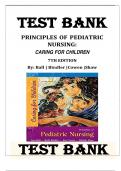TEST BANK
PRINCIPLES OF PEDIATRIC
U
NURSING:
LT
CARING FOR CHILDREN
7TH EDITION
IM
By: Ball | Bindler |Cowen |Shaw
AT
ES
TU
D
Y
TEST BANK
,Principles of Pediatric Nursing: Caring for Children, 7e Jane W. Ball (et al.) Test Bank
Table of contents
Chapter 1: Nurse's Role in Care of the Child: Hospital, Community, and Home
Chapter 2: Family-Centered Care and Cultural Considerations
Chapter 3: Genetic and Genomic Influences
U
Chapter 4: Growth and Development
Chapter 5: Pediatric Assessment
LT
Chapter 6: Introduction to Health Promotion and Maintenance
Chapter 7: Health Promotion and Maintenance for the Newborn and Infant
Chapter 8: Health Promotion and Maintenance for the Toddler and Preschooler
IM
Chapter 9: Health Promotion and Maintenance for the School-Age Child and Adolescent
Chapter 10: Nursing Considerations for the Child in the Community
Chapter 11: Nursing Considerations for the Hospitalized Child
AT
Chapter 12: The Child with a Chronic Condition
Chapter 13: The Child with a Life-Threatening Condition and End-of-Life Care
Chapter 14: Infant, Child, and Adolescent Nutrition
Chapter 15: Pain Assessment and Management in Children
ES
Chapter 16: Immunizations and Communicable Diseases
Chapter 17: Social and Environmental Influences on the Child
Chapter 18: Alterations in Fluid, Electrolyte, and Acid–Base Balance
TU
Chapter 19: Alterations in Eye, Ear, Nose, and Throat Function
Chapter 20: Alterations in Respiratory Function
Chapter 21: Alterations in Cardiovascular Function
Chapter 22: Alterations in Immune Function
D
Chapter 23: Alterations in Hematologic Function
Chapter 24: The Child with Cancer
Y
Chapter 25: Alterations in Gastrointestinal Function
Chapter 26: Alterations in Genitourinary Function
Chapter 27: Alterations in Neurologic Function
Chapter 28: Alterations in Mental Health and Cognition
Chapter 29: Alterations in Musculoskeletal Function
Chapter 30: Alterations in Endocrine and Metabolic Function
Chapter 31: Alterations in Skin Integrity
,Principles of Pediatric Nursing: Caring for Children, 7e Jane W. Ball (et al.)
Chapter 1: Nurse's Role in Care of the Child: Hospital, Community, and Home
1) Which nursing role is not directly involved when providing family-centered approach to the
pediatric population?
1. Advocacy
U
2. Case management
3. Patient education
LT
4. Researcher
Answer: 4
Explanation: 1. A researcher is not involved in the family-centered approach to patient care of
IM
children and their families. Advocacy, case management, and patient education are all roles
directly involved in the care of children and their families.
2. A researcher is not involved in the family-centered approach to patient care of children and
AT
their families. Advocacy, case management, and patient education are all roles directly involved
in the care of children and their families.
3. A researcher is not involved in the family-centered approach to patient care of children and
ES
their families. Advocacy, case management, and patient education are all roles directly involved
in the care of children and their families.
4. A researcher is not involved in the family-centered approach to patient care of children and
their families. Advocacy, case management, and patient education are all roles directly involved
TU
in the care of children and their families.
Page Ref: 4
Cognitive Level: Analyzing
Client Need &Sub: Safe and Effective Care Environment: Management of Care
D
Standards: QSEN Competencies: Patient-centered care | AACN Essential Competencies:
Essential II: Basic organizational and systems leadership for quality care and patient safety |
Y
NLN Competencies: Professional identity | Nursing/Integrated Concepts: Nursing Process:
Assessment/Coordination of care
Learning Outcome: LO 1.2 Compare the roles of nurses in child healthcare.
MNL LO: Family-centered care
, 2) A nurse is working with pediatric clients in a research facility. The nurse recognizes that
federal guidelines are in place that delineate which pediatrics clients must give assent for
participation in research trials. Based upon the client's age, the nurse would seek assent from
which children?
Select all that apply.
1. The precocious 4-year-old commencing as a cystic fibrosis research-study participant.
U
2. The 7-year-old leukemia client electing to receive a newly developed medication, now being
researched.
LT
3. The 10-year-old commencing in an investigative study for clients with precocious puberty.
4. The 13-year-old client commencing participation in a research program for Attention Deficit
Hyperactivity Disorder (ADHD) treatments.
IM
Answer: 2, 3, 4
Explanation: 1. Federal guidelines mandate that research participants 7 years old and older must
receive developmentally appropriate information about healthcare procedures and treatments and
AT
give assent.
2. Federal guidelines mandate that research participants 7 years old and older must receive
developmentally appropriate information about healthcare procedures and treatments and give
ES
assent.
3. Federal guidelines mandate that research participants 7 years old and older must receive
developmentally appropriate information about healthcare procedures and treatments and give
assent.
TU
4. Federal guidelines mandate that research participants 7 years old and older must receive
developmentally appropriate information about healthcare procedures and treatments and give
assent.
Page Ref: 11, 12
D
Cognitive Level: Applying
Client Need &Sub: Psychosocial Integrity
Y
Standards: QSEN Competencies: Patient-centered care | AACN Essential Competencies:
Essential V: Healthcare policy, finance, and regulatory environments | NLN Competencies:
Nursing judgement | Nursing/Integrated Concepts: Nursing Process: Planning/Coordination of
care
Learning Outcome: LO 1.6 Examine three unique pediatric legal and ethical issues in pediatric
nursing practice.
MNL LO: Developmentally appropriate care





